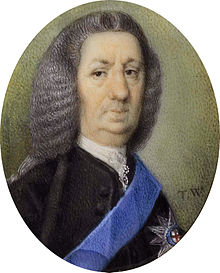Daniel Finch, 8th Earl of Winchilsea
This article needs additional citations for verification. (September 2014) |
Daniel Finch, 8th Earl of Winchilsea, 3rd Earl of Nottingham | |
|---|---|
 Daniel Finch (1689-1769), 8th Earl of Winchilsea, 3rd Earl of Nottingham (Thomas Worlidge) | |
| Lord President of the Council | |
| In office 12 July 1765 – 30 July 1766 | |
| Monarch | George III |
| Prime Minister | The Marquess of Rockingham |
| Preceded by | The Duke of Bedford |
| Succeeded by | The Earl of Northington |
Daniel Finch, 8th Earl of Winchilsea and 3rd Earl of Nottingham, KG PC (24 May 1689 – 2 August 1769) was a British politician.
Life
Styled Lord Finch until 1730, he was the eldest son of Daniel Finch, 2nd Earl of Nottingham and his second wife Anne Hatton, daughter of Christopher Hatton, 1st Viscount Hatton. His father was a prominent Tory politician who had been one of the few leading Tories to actively support the Hanoverian succession.
As Lord Finch, he was elected when only 21 as Member of Parliament for Rutland. He remained its member until he succeeded to the Earldom in 1730, also serving as comptroller of the royal household from 1725 to 1730. Winchilsea supported the creation of London's Foundling Hospital, a charity providing home and education for some of the capital's many abandoned children. Winchilsea was one of the original governors for this organisation, founded in 1739.
Although his father had been a supporter of Walpole, Winchilsea became instead a supporter of Lord Carteret in the so-called "Patriot Opposition". When Carteret became leading minister in 1742, Winchilsea joined as well, becoming First Lord of the Admiralty (1742–1744). Later on, he allied himself with Newcastle and the Old Whigs, and served as Lord President in the Rockingham administration (1765–1766).
He was made a Knight of the Garter in 1752.
He first married Lady Frances Feilding, daughter of Basil Feilding, 4th Earl of Denbigh and Hester Firebrace, with whom he had a daughter, Lady Charlotte. He later married Mary Palmer, daughter of Sir Thomas Palmer, 1st Baronet Palmer. They had four daughters: Ladies Heneage, Essex, Hatton and Augusta, and four more who died young. They died unmarried and there are no known descendants.[1]
References
- ^ The New Peerage; Or, Present State of the Nobility of England, 1769, p77
- Use dmy dates from January 2012
- 1689 births
- 1769 deaths
- British MPs 1710–13
- British MPs 1713–15
- British MPs 1715–22
- British MPs 1722–27
- British MPs 1727–34
- Members of the Parliament of Great Britain for English constituencies
- Lord Presidents of the Council
- Earls of Winchilsea
- Earls of Nottingham
- Lords of the Admiralty
- Knights of the Garter
- Members of the Privy Council of Great Britain
- Finch-Hatton family
